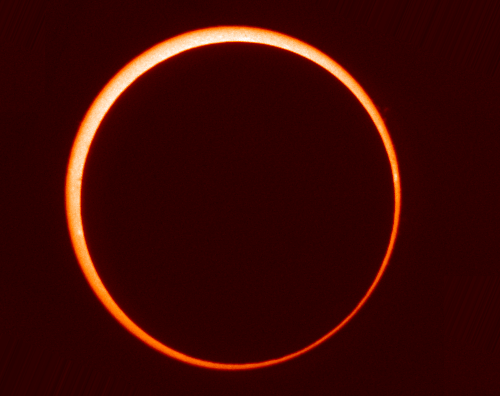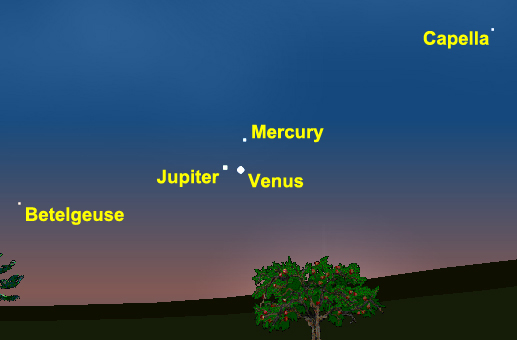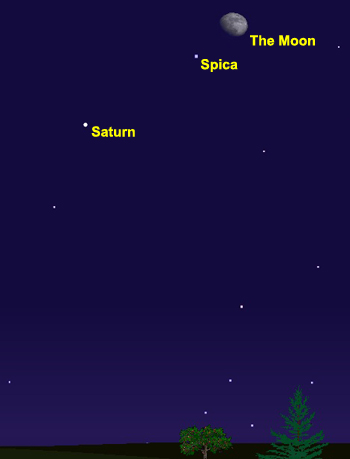There’s a lot going on in the night sky this month: a meteor shower this coming weekend; a solar eclipse visible from Australia and Hawaii; and a beautiful alignment of Jupiter, Venus and Mercury over Memorial Day in late May.
Meteor shower in the Name A Star Live constellation Aquarius May 5/6

Over the night of May 5/6, you may see one of the best meteor showers of the year — the “Eta Aquarid” shower. Composed of tiny dust particles left by Halley’s Comet on its previous visits to our neck of the solar system, this year’s Eta Aquarid meteor shower promises to be impressive because moonlight will not interfere with the show. When the Moon is out, the bright light of the Moon makes it difficult to see many of the fainter “shooting stars” of a meteor shower. But on the night of the meteor shower’s peak — May 5/6 — the Moon will not rise until around 4:00 am (the morning of May 6). It’s called the “Eta Aquarid” meteor shower because the shooting stars all seem to emanate from a particular point in the constellation Aquarius.
The best way to view a meteor shower is to lie down in a lawn chair or on a blanket — face up — and enjoy the show! No telescopes or binoculars needed. The absolute best time to view the largest number of meteors per hour will be between 3 and 4 am May 6. But really, you can still see a lot of shooting stars the evening of May 5 — and over the nights of May 3, 4, 7 and 8 as well. Those of you in the southern hemisphere of Earth (e.g., Australia, New Zealand, etc.) should get a particularly good view.
Remember to bring along insect repellant or warm clothes, as your weather may dictate, and have a great time!
Solar eclipse visible from Australia and Hawaii May 9/10

No matter where you live, you can watch the eclipse live, via the Internet.
Also, check out this video that shows the path of the eclipse:
A trio of planets for Memorial Day
In late May — during the Memorial Day period in the United States — the planets Jupiter, Venus and Mercury will align together around sunset, and will be viewable just over over the western horizon. These “planetary conjunctions” do not happen often, so be sure to take a gander at this heavenly display!

Star hop to Saturn

Star hopping is when you use bright, easy-to-identify objects in the night sky to find harder-to-identify objects. It’s like using landmarks on Earth.
On the evening of May 21, 2013 you can star hop to Saturn! Face southeast and start with the Moon. Look for the bright point of light down, and to the left of the Moon: That’s the star Spica. Then, look further down and to the left: The bright point of light you’ll see is the planet Saturn. You can easily see Saturn’s rings through just about any telescope. While you look at Saturn’s rings, see if you can detect a dark circle within the rings: That’s the famous “Cassini division.”
For those of you in the southern hemisphere of Earth (such as Australia, New Zealand, South Africa, etc.), you should face east the evening of May 21 as well (your time). In your case, Spica will be down, and to the right of the Moon, and Saturn will be down, and to the right of Spica.
The Moon and Saturn will be in the Name A Star Live constellation Virgo that evening. Spica is Virgo’s brightest star.
Finding your star in the night sky
Stars are located within constellations, which are just areas of the night sky. Scorpius, Aries and Taurus are examples of constellations. Your Name A Star Live Star Certificate displays the name of your constellation. You can use our online World Constellation Guide to determine if you can see your constellation during the evening hours (between sunset and midnight). Of course, you’ll need a telescope to see your star. But you can see your constellation without the use of a telescope. You can also find your constellation by using our Virtual Planetarium™ astronomy software. A planisphere is another useful device.


